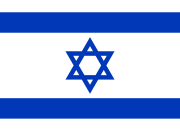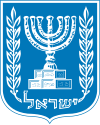Flag of Israel

 National flag. Flag ratio: 8:11
National flag. Flag ratio: 8:11| State of Israel |
|---|
 |
The flag of Israel was adopted on October 28, 1948, five months after the nation's establishment. It depicts a blue Star of David on a white background, between two horizontal blue stripes. The blue color is mandated only as "dark sky-blue",[1] and varies from flag to flag, ranging from a hue of pure blue, sometimes shaded almost as dark as navy blue, to hues about 75% toward pure cyan and shades as light as very light blue.[2]
Origin of the flag


 Civil ensign. Flag ratio: 2:3
Civil ensign. Flag ratio: 2:3
 Naval ensign. Flag ratio: 2:3
Naval ensign. Flag ratio: 2:3The flag of the State of Israel is intended to portray a Star of David on a tallit, the traditional Jewish prayer shawl.
The Israelites used an indigo colored dye called tekhelet; this dye is now believed to have been made from the snail murex trunculus. This dye was very important in both Jewish and non-Jewish cultures of this time, and was used by royalty and the upper class in dyeing their clothing, sheets, curtains, etc. (The dye from a related snail can be processed to form Tyrian purple called argaman.)
In the Torah, the Israelites are commanded to dye one of the threads of their tallit (prayer shawl) with tekhelet; when they look at this dye they will think of the blue sky, and of the God above them in Heaven. Tekhelet corresponds to the color of the divine revelation (Midrash Numbers Rabbah xv.). Sometime near the end of the Talmudic era (500-600 CE) the industry that produced this dye collapsed. It became more rare; over time the Jewish community lost the tradition of which species of shellfish produced this dye. Since Jews were then unable to fulfil this commandment, they have since left their tzitzit (tallit strings) white. However, in remembrance of the commandment to use the tekhelet dye, it became common for Jews to have blue or purple stripes on their tallit. [3] The idea that the blue and white colors were the national color of the Jewish people was voiced by early on Ludwig August Frankl (1810-1894), an Austrian Jewish poet. In his poem, "Judah's Colors", he writes:
When sublime feelings his heart fill, he is mantled in the colors of his country. He stands in prayer, wrapped in a sparkling robe of white.
The hems of the white robe are crowned with broad stripes of blue; Like the robe of the High Priest, adorned with bands of blue threads.
These are the colors of the beloved country, blue and white are the borders of Judah; White is the radiance of the priesthood, and blue, the splendors of the firmament.[4]
In 1885 the agricultural village of Rishon LeZion used a blue and white flag to mark its third anniversary. A blue and white flag, with a Star of David and the Hebrew word "Maccabee", was used in 1891 by the Bnai Zion Educational Society.
David Wolffsohn (1856-1914), a businessman prominent in the early Zionist movement, was aware that the nascent Zionist movement had no official flag, and that the design proposed by Theodore Herzl was gaining no significant support. He writes:
At the behest of our leader Herzl, I came to Basle to make preparations for the Zionist Congress. Among many other problems that occupied me then was one that contained something of the essence of the Jewish problem. What flag would we hang in the Congress Hall? Then an idea struck me. We have a flag — and it is blue and white. The talith (prayer shawl) with which we wrap ourselves when we pray: that is our symbol. Let us take this Talith from its bag and unroll it before the eyes of Israel and the eyes of all nations. So I ordered a blue and white flag with the Shield of David painted upon it. That is how the national flag, that flew over Congress Hall, came into being.
While this flag emphasizes Jewish religious symbols, Theodor Herzl wanted the flag to have more universal symbols: 7 golden stars symbolizing the 7-hour working quota of the enlightened state-to-be, which would have advanced socialist legislations. [5]
-
1929. Moorish Zionist Temple of Black Jews. Harlem. Jewish flag is next to American flag in the background.
-
1944. The Jewish Brigade headquarters during World War II. Both Union Jack and the Jewish flag are visible.
-
July 15, 1945. Buchenwald survivors arrive in Haifa.
-
2006. The Israeli Flag stands next to the Western Wall.
Controversies
Claims of "Nile to Euphrates" territorial ambitions
It has been alleged by some groups that the blue stripes on the Israeli flag actually represent the rivers Nile and Euphrates, which some Zionist thinkers (such as Avraham Stern and Israel Eldad) had claimed as the boundaries of Eretz Yisrael, the land promised to the Jews by God. [6] Those making this allegation insist that the flag "secretly" represents the desire of Jews to conquer all of the land between the Nile and Euphrates rivers, which would involve conquering and ruling over much of Egypt, all of Jordan, and some of Syria and Iraq. Yasser Arafat also made the allegation, [7] and repeatedly tied this notion to the stripes on the Israeli flag. [8] [9]
Both Zionist and anti-Zionist authors have debunked the claim that the stripes on the flag represent territorial ambitions. Daniel Pipes notes "In fact, the blue lines derive from the design on the traditional Jewish prayer shawl", [10] and Danny Rubenstein points out that "...Arafat... added, in interviews that he gave in the past, that the two blue stripes on the Israeli flag represent the Nile and the Euphrates... No Israeli, even those who demonstrate understanding for Palestinian distress, will accept the... nonsense about the blue stripes on the flag, which was designed according to the colors of the traditional tallit (prayer shawl)..."[9] Persistent critic of Israel and Zionism Israel Shahak is equally explicit. In his The Zionist Plan for the Middle East he states
A good example is the very persistent belief in the non-existent writing on the wall of the Knesset of the Biblical verse about the Nile and the Euphrates. Another example is the persistent, and completely false declarations, which were made by some of the most important Arab leaders, that the two blue stripes of the Israeli flag symbolize the Nile and the Euphrates, while in fact they are taken from the stripes of the Jewish praying shawl (Talit).
Saqr Abu Fakhr, an Arab writer, has also spoken out against this idea. He demonstrates that the "Nile to Euphrates" claim regarding the flag is one of seven popular misconceptions and/or myths about Jews which, despite being unfounded and having abundant evidence refuting them, continue to circulate in the Arab world. [11]
Nevertheless, the Hamas Covenant states "After Palestine, the Zionists aspire to expand from the Nile to the Euphrates," and as recently as January 29, 2006, Hamas leader Mahmoud al-Zahar issued a demand for Israel to change its flag, citing the "Nile to Euphrates" argument. [12]
Proposals to change the flag
It has recently been suggested that additional symbols be added to the flag with which non-Jewish citizens of Israel, such as Israeli Arabs, would be able to identify. Such proposals have not gathered any significant percentage of public support.
See also
References
- ^ Israel Ministry of Foreign Affairs publication The Flag and the Emblem by art historian Alec Mishory, wherin he quotes "The Provisional Council of State Proclamation of the Flag of the State of Israel" made on October 28, 1948 by Joseph Sprinzak, Speaker.
- ^ Varied examples; Flag ~75% toward cyan from pure blue full article:The Flag and the Emblem Accessed July 28, 2006.
- ^ Simmons, Rabbi Shraga. Tallit stripes, About.com's "Ask the Rabbi". Accessed April 3, 2006.
- ^ Frankl, A. L. "Juda's Farben", in Ahnenbilder (Leipzig, 1864), p. 127
- ^ Sholem, G. "The Curious History of the Six Pointed Star; How the 'Magen David' Became the Jewish Symbol", Commentary, 8 (1949) pp. 243-351.
- ^ Genesis 18: "The Lord made a covenant with Abram, saying unto thy seed have I given this land from the river of Egypt [the Nile] unto the great river, the River Euphrates."
- ^ Playboy Interview: Yasir Arafat, Playboy Magazine, September 1988.
ARAFAT: Yes, because they don't want it. Look at the slogans they use: that the land of Israel is from the Euphrates to the Nile. This was written for many years over the entrance to the Knesset, the parliament. It shows their national ambition-they want to advance to the Jordan River. One Israel for them, what's left for us.... Do you know what the meaning of the Israeli flag is?
PLAYBOY: No.
ARAFAT: It is white with two blue lines. The two lines represent two rivers, and in between is Israel. The rivers are the Nile and the Euphrates. - ^ Rubin, Barry. The PLO between Anti-Zionism and Antisemitism, Background and Recent Developments, The Vidal Sassoon International Center for the Study of Antisemitism, The Hebrew University of Jerusalem, 1993. Accessed Apr 3, 2006.
- ^ a b Rubenstien, Danny. Inflammatory legends, Haaretz, November 15, 2004. Accessed April 3, 2006.
- ^ Pipes, Daniel. Imperial Israel: The Nile-to-Euphrates Calumny, Middle East Quarterly, March, 1994. Accessed April 3, 2006.
- ^ Abu Fakhr, Saqr. "Seven Prejudices about the Jews", Al-Hayat, November 12,13,14, 1997.
- ^ Shiloh, Scott. Mofaz: Hamas Acting Responsibly; Hamas: Israel Must Change Flag, Arutz Sheva, January 30, 2006. Accessed April 3, 2006.
External link


